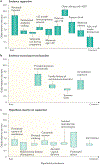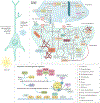Autism spectrum disorder
- PMID: 31949163
- PMCID: PMC8900942
- DOI: 10.1038/s41572-019-0138-4
Autism spectrum disorder
Abstract
Autism spectrum disorder is a construct used to describe individuals with a specific combination of impairments in social communication and repetitive behaviours, highly restricted interests and/or sensory behaviours beginning early in life. The worldwide prevalence of autism is just under 1%, but estimates are higher in high-income countries. Although gross brain pathology is not characteristic of autism, subtle anatomical and functional differences have been observed in post-mortem, neuroimaging and electrophysiological studies. Initially, it was hoped that accurate measurement of behavioural phenotypes would lead to specific genetic subtypes, but genetic findings have mainly applied to heterogeneous groups that are not specific to autism. Psychosocial interventions in children can improve specific behaviours, such as joint attention, language and social engagement, that may affect further development and could reduce symptom severity. However, further research is necessary to identify the long-term needs of people with autism, and treatments and the mechanisms behind them that could result in improved independence and quality of life over time. Families are often the major source of support for people with autism throughout much of life and need to be considered, along with the perspectives of autistic individuals, in both research and practice.
Figures







References
-
- Lord C et al. Autism from 2 to 9 years of age. Arch. Gen. Psychiatry 63, 694–701 (2006). - PubMed
-
This paper establishes that autism is a stable diagnosis (as a spectrum) beginning at least by 2 years of age. The paper also establishes parent interview and clinician observation as predictive of autism at 9 years of age. Finally, it is the first paper that shows that the specific DSM-IV-TR diagnoses is unstable across childhood but that the instability is almost all shifting across categories not outside the spectrum.
-
- Risi S et al. Combining information from multiple sources in the diagnosis of autism spectrum disorders. J. Am. Acad. Child Adolesc. Psychiatry 45, 1094–1103 (2006). - PubMed
-
- Loomes R, Hull L & Mandy WPL What is the male-to-female ratio in autism spectrum disorder? A systematic review and meta-analysis. J. Am. Acad. Child Adolesc. Psychiatry 56, 466–474 (2017). - PubMed
-
- Brugha TS et al. Epidemiology of autism in adults across age groups and ability levels. Br. J. Psychiatry 209, 498–503 (2016). - PubMed
-
This paper uses active case-finding to provide representative estimates of the prevalence of autism and demonstrated that rates of autism in men and women are equivalent in adults with moderate-to-profound intellectual disability.
-
- Brugha T, Bankart J, McManus S & Gullon-Scott F CDC autism rate: misplaced reliance on passive sampling? Lancet 392, 732–733 (2018). - PubMed
Publication types
MeSH terms
Grants and funding
- R01 MH110928/MH/NIMH NIH HHS/United States
- R03 MH112783/MH/NIMH NIH HHS/United States
- U01 MH105575/MH/NIMH NIH HHS/United States
- MR/K021389/1/MRC_/Medical Research Council/United Kingdom
- R34 MH104428/MH/NIMH NIH HHS/United States
- R01 MH094604/MH/NIMH NIH HHS/United States
- R01 MH102342/MH/NIMH NIH HHS/United States
- R01 MH081873/MH/NIMH NIH HHS/United States
- R01 MH109901/MH/NIMH NIH HHS/United States
- U01 MH111662/MH/NIMH NIH HHS/United States
- R01 MH114999/MH/NIMH NIH HHS/United States
- P50 MH106934/MH/NIMH NIH HHS/United States
- MR/T003057/1/MRC_/Medical Research Council/United Kingdom
- U01 MH115747/MH/NIMH NIH HHS/United States
- R01 HD081199/HD/NICHD NIH HHS/United States
- R01 MH116058/MH/NIMH NIH HHS/United States
- T32 MH016434/MH/NIMH NIH HHS/United States
LinkOut - more resources
Full Text Sources
Other Literature Sources
Medical

